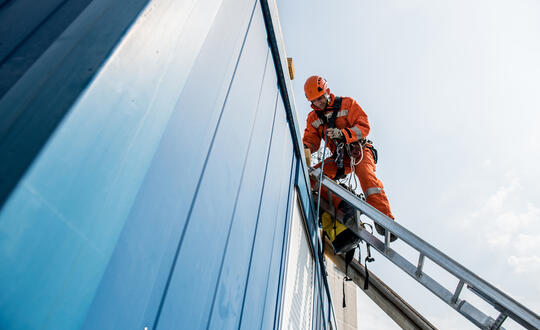
The Building Safety Bill finally received its Royal Assent on 28 April. It is now known as the Building Safety Act 2022 (BSA).
A great deal is going to be written about the provisions of the BSA but in many cases the detail has yet to be produced. In the meantime, and as a quick reminder, here are five things that you need to know right now about the BSA:
1. The first changes – new rights, plus extended periods for bringing claims
One of the first steps to be taken in the transitional period will be the introduction of extended limitation periods for certain claims under the Defective Premises Act (DPA), the introduction of a new Section 2A to the DPA, and bringing Section 38 of the Building Act 1984 into force.
Before the BSA, a claim was available under Section 1 of the DPA in relation to works carried out by the original builder only during the original construction or substantial refurbishment of the building. A claim could be brought by the building owner or leaseholder. This was in relation to the question of whether the building was fit for habitation or not. The standard limitation period for an action of this sort under statute was six years.
However, the BSA changes this. It is going to extend that limitation period in relation to claims under Section 1 of the DPA from six years to 30 years and, furthermore, this limitation period will apply retrospectively as well as prospectively (ie backwards as well as forwards). This means that from the date this provision comes into force, those able to bring such a claim will be able to do so for any relevant works carried out on buildings since around mid-1992.
The BSA is also introducing a new claim under Section 2A of the DPA. This is a claim that can be brought in relation to any subsequent building works to the building and is available to the existing leaseholder as well as the building owners. There is a 15 year limitation period applicable to this claim, but it is only prospective, not retrospective.
Finally, Section 38 of the Building Act is finally brought into force, having laid dormant since 1984. This allows claims by anyone in relation to damage they have suffered arising out of the misapplication or failure to apply the relevant Building Regulations. "Damage" in this case encompasses physical and even mental damage as well as money claims. Again the limitation for these claims is 15 years and it is prospective only.
These changes will be made very soon – on the basis of the indicative timescale published with the original BSA, we can expect these changes to happen over the summer.
2. It's not just about buildings over 18 metres
Much of the BSA applies to "higher risk" or "in-scope" buildings. Confusingly, there are three separate definitions of what constitutes a "higher risk", "in-scope" or "relevant" building depending upon which part of the BSA you are looking at. These are as follows:
(a) For the purposes of Part 3 of the BSA, dealing with buildings during the construction phase, the BSA defines a "higher risk" building as a building that is at least 18 metres in height or has at least seven storeys and is of a description specified in relevant regulations. Draft regulations currently state that the following types of buildings are "higher risk buildings" for the purposes of the Building Act 1984:
- a building that contains at least two residential units
- a care home
- a hospital.
The Regulations also exclude the following from this definition:
- a secure residential institution
- a temporary leisure establishment
- military premises.
(b) For the purposes of Part 4 of the BSA, dealing with buildings that are occupied, the general definition of at least 18 metres in height and seven storeys also applies but also that the building must contain at least two residential units. The relevant draft regulations however provide that buildings are excluded from the relevant definition if they are comprised entirely of:
- a care home
- a hospital
- a security residential institution
- a temporary leisure establishment
- military premises.
(c) Confusingly, in the new Schedule 8 introduced by way of amendments to the BSA in February 2022 dealing with leaseholder protection. the definition of "relevant building" is a building of 11 metres in height or comprised of at least five storeys.
The BSA allows the definition of "higher risk buildings" to be amended. Consequently, it is not safe to assume that the 18 metre/seven storey restriction will remain indefinitely. There has been discussion around changing the definition of "higher risk building" to 11 metres/five storeys and it is possible that the introduction of this criteria in Schedule 8 is a foretaste of what may come.
3. There are new duties for relevant stakeholders to get to grips with
The BSA establishes additional duties on parties during the construction phase (known as dutyholders) and establishes the new office of the Accountable Person in relation to those responsible for the building during the occupational phase.
The dutyholders during the construction phase largely mirror those already established for the purposes of Health and Safety Regulations (CDM Regulations) and would include the contractor, the client and the architect.
The Accountable Person during the occupational phase will have to manage building safety risks. This includes obtaining a Building Assessment Certificate and registering the building with the Building Safety Regulator (BSR).
Full details about dutyholders, and about the Accountable Person's role and responsibilities will be made available at some point in phase 3 of the transitional period which is within 18 months of Royal Assent; that is, probably during the second half of 2023.
4. The building safety regime itself will be bolstered
More generally, the building safety regime will be tightened and strengthened considerably.
The BSR is already in office and is responsible for the safety and performance of all buildings as well as implementing the new, more stringent regime for higher-risk buildings. The structure of building control will also change: Approved Inspectors will be replaced by Building Control Approvers and the new office of Building Control Inspector will be created, largely replacing local authority building control. The BSR will maintain a register of these appointments and will introduce a code of conduct. It will no longer be possible to choose the building control body that oversees work to higher-risk buildings: these will be overseen by the BSR.
5. Leaseholders will be better protected financially
There are a raft of provisions coming into operation limiting leaseholders' liability to pay for remedial works to defective buildings.
As noted above these changes, which were introduced by the government in February of this year, are based upon a slightly different definition of "relevant building", which is 11 metres or five storeys in height rather than the 18 metres/seven storey limit applied elsewhere in the BSA.
Careful consideration should also be given to the definition of "Qualifying Lease" and the financial limits in relation to the caps on permitted service charges (known as a "permitted amount").
Remediation orders can be issued against landlords requiring them to remedy relevant defects. The protection is not limited to cladding issues but covers "relevant defects" that cause a "building safety risk". This encompasses a risk to the safety of people in or about the building arising from either the spread of fire, or the collapse of the building or any part of it. These changes are too complex to go into here, but should be very carefully considered.
What now?
The transitional period is now underway. The indicative timescale published with the BSA is still useful in terms of setting out when various steps will be taken, but it is important that what is coming up is understood now and that everyone starts to prepare for the changes that will take place.
The granting of Royal Assent is very much the beginning of what will be a very long process which will keep all stakeholders in the construction sector busy until at least the end of 2023 and probably well beyond.
This article is for general information only and reflects the position at the date of publication. It does not constitute legal advice.





